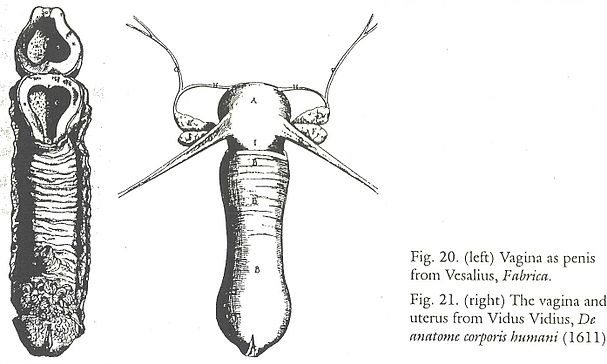Thomas Laqueur is an American scientist whose main research is culture and history of sexology. In his book "Making Sex: Body and Gender from the Greeks to Freud" he postulates the hypothesis that prior to the eighteenth century in European culture man was regarded as prototype, that is, an ideal of a human being. Woman was only described as imperfect man. Laqueur called it the one-sex model. [1] [2] [3]
Another belief was that due to missing female heat a woman's vagina was an interior penis and due to male heat a man's penis was outside the body. Basically, women and men possessed the same organs as men, the only difference being that female testicles were in a protected place, namely the woman's abdomen. This way, the female body was perceived as a less perfect version of the male body instead of two completely different biological systems. However, this theory primarily refers to the sex. According to Laqueur, there was more than one gender which described the social role, that is, a special position which a woman or man had in the social order. [1] [2] [3]
From the 18th century on, fundamental change in attitudes toward human sexual anatomy occurred, mainly due to new scientific findings. In the two-sex model, women and men began to be seen as polar opposites and each sex considered different and therefore received an individual name. For Lacqueur, this change of perspective is not only based on scientific progress but is a scientific revolution as defined by the American philosopher and historian of science Thomas Kuhn. [1] [2] [3]
Criticism shows that the one-sex model was not valid in ancient times and only partly in medieval Europe. Both models rather co-existed in different times and places, however, the two-sex model became prevalent. [1] [4]
The concept of „third gender" was coined in 1899 by the German author Ernst von Wolzogen. At the end of the 20th century, this term re-emerged in the context of queer theory and transgender movement. Nowadays, the term third gender is used for intersexual and transsexual people. [TRANSGENDER IDENTITY] [INTERSEXUAL] However, this model is criticized for promoting further undifferentiated way of thinking. [1] [5]

„Vagina-Vesalius“ von Andreas Vesalius
Thomas Laqueur: Making Sex, Harvard University Press, 1991
Quellenangabe:
https://de.wikipedia.org/wiki/Datei:Vagina-
Vesalius.jpg#/media/File:Vagina-Vesalius.jpg

